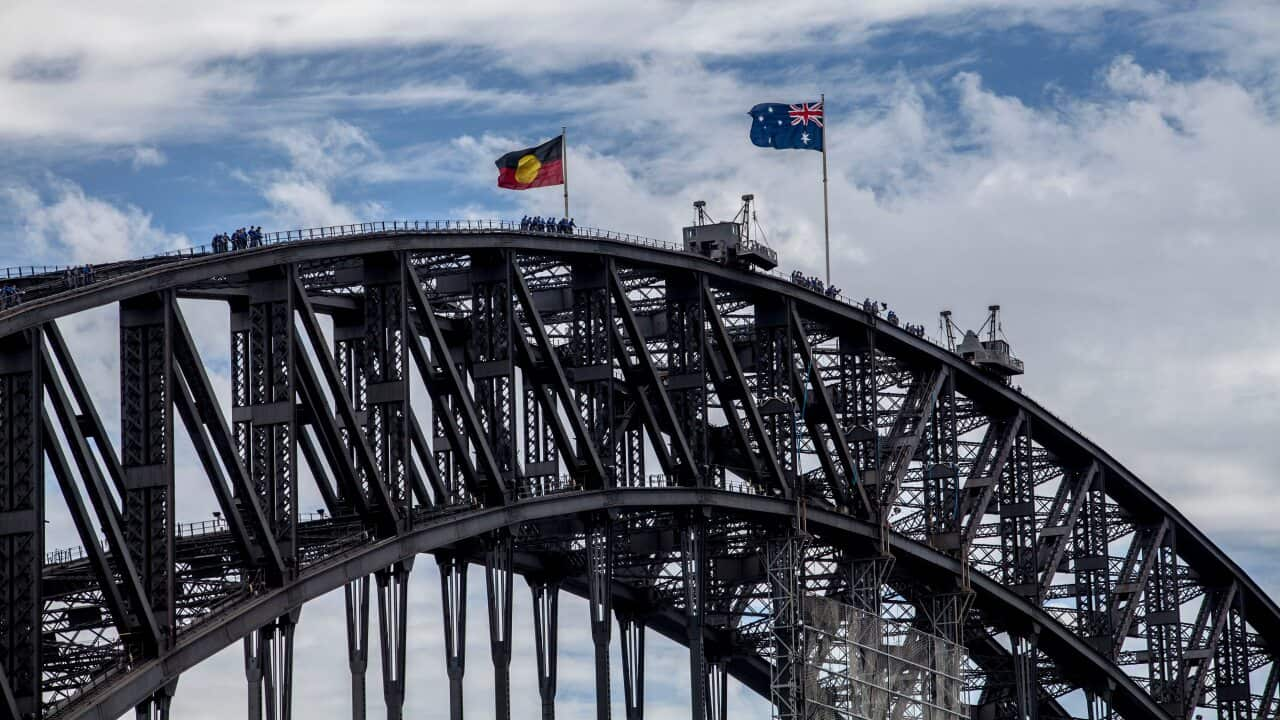Towering of the waters of Sydney, the Harbour Bridge is one of the nation’s most iconic landmarks.
Opened on March 19, 1932, the bridge has seen 90-years of change, and there's been a number of powerful Blak moments in that time.
On the land
The Bridge’s southern pylons stand on Dawes Point, known in Gadigal as Tar-Ra.
This is the site where English Lieutenant and astronomer William Dawes, of the First Fleet, build an observatory in April of 1788. A home to Dawes, the observatory was said to be a welcoming place for Aboriginal people.
It was here Dawes met Patyegarang, a 15-year-old Gamaraigal girl. Over time their bond grew, and Patyegarang taught Dawes language.
The pair would share information about their day, and Dawes would transcribe their conversations. These diaries are the only recorded first-hand accounts of Gadigal language.

Patyegarang and Dawe's conversations written in his notebooks. Source: Sydney Festival 2017
La Perouse love
In July of 1923, construction began on the bridge. Taking form amid the Great Depression, history says the structure began a symbol of hope for those surrounding – including Aboriginal people living on La Perouse Reserve.
When the bridge officially opened in 1932, many members of the La Perouse community were there.
Images of the bridge seeped their way into art created at LaPa, from rock carvings, to carved boomerangs and shell models of the bridge that are still made today.

Sydney Harbour Bridge Boomerang made by Tommie Foster, 1928. Source: Powerhouse Museum
The walk for Reconciliation
The People’s Walk for Reconciliation in the year 2000 is one of the most memorable moments in the bridge’s history.
On May 28, an estimated quarter-of-a-million people walked across the bridge in honour of reconciliation – a commitment to moving forward and supporting Indigenous peoples, communities and rights.
In the crowd of 250,000 was the CEO of Reconciliation Australia, Karen Mundine.
On the “cusp of a new century”, the Bundjalung woman remembers walking across the bridge alongside her family.
“I have crystal clear memory of walking across the Sydney Harbour Bridge that day with my family, including my Grandfather and my Mum,” she said.
“Those hundreds of thousands of people who voted with their feet for reconciliation, who marched across bridges were ready for something more. Once they’d crossed the bridges there was no turning back, they were ready to take bigger steps.”
By the end of 2000, Walks for Reconciliation had taken place right across the nation in what Ms Mundine described as the “largest display of public support for a single cause in Australian history”.

Still of the 2000 Bridge walk for Reconciliation. Source: Supplied
Legacies in light
In 2009, Sydney welcomed the Vivid: Light, Music and Ideas Festival, and five years later Bangarra Dance Theatre created EORA.
EORA paid was a homage to First Peoples with creative and captivating projections projected onto the bridge’s southern pylon.
Beginning in 2014, Bangarra paid homage to Patyegarang with EORA: The Spirit of Patyegarang onto the podium.
In 2015, Bangarra debuted EORA: The Fisherwoman, continuing in 2016 with EORA: The Land that paid respect to Sydney’s Traditional Owners.
In 2017, Vivid welcomed EORA: Bennelong – a tribute to Australia’s first Aboriginal diplomat and in 2018, EORA: Dark Emu.

Bangarra's EORA for Sydney's Vivid. Source: Supplied
Stories at the summit
In January of 2021, the Sydney Festival welcomed Burrawa Bridge Climb, Burrawa meaning “above” in language.
The climb was the brainchild of Sydney Festival artistic director Wesley Enoch and BridgeClimb Owner David Hammon.
For the first time in history, local Aboriginal stories and histories were told from the structure, including the stories of Bennelong, Barangaroo and Patyegarang.
The livelihood of the climb continued after the Festival, now cemented as a regular attraction.

Matty Mills leading a group on the Burrawa Bridge Climb. Source: Supplied
The flag to stand tall
In February of this year, the NSW Government announced its intent to fly the Aboriginal flag permanently on the bridge.
The decision was a result of five years of advocacy led by Kamilaroi woman Cheree Toka.
The Aboriginal flag will be flown alongside the Australian flag 365 days a year, as a “powerful visualisation of equality."
“The Aboriginal flag is a reminder that the country has a history before European arrival,” she said.
“Thousands of people visit Sydney . . . and I think it’s a powerful reminder that First Nations people have always been here and will always be here standing up for our rights.”
Despite the commitment from Government, the flag won’t take its place until a flagpole is erected, which could take anywhere between 6-months to 3-years.

Cheree at a demonstration in 2018. Source: AAP


